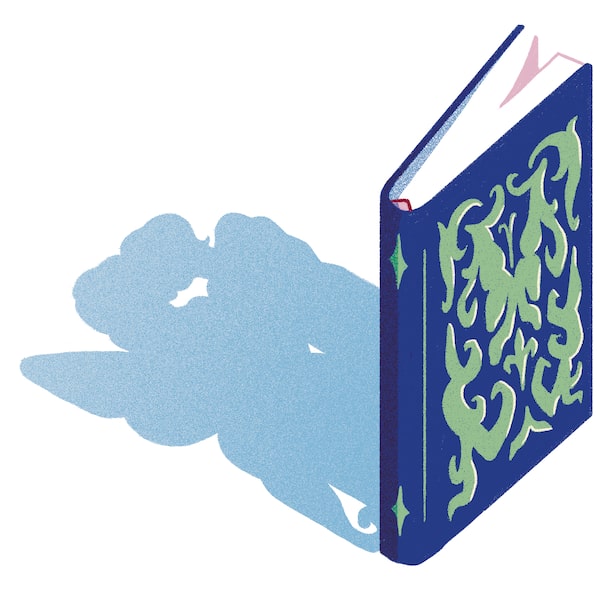
Illustration by Wenting Li
Midnight release parties at bookstores. Eye-watering sales figures – 100,000 sold a day. Fandoms that weave elaborate theories while counting down the days to the next instalment in the series.
You’d be forgiven for thinking you’d teleported to 1999, back to a planet in the grips of Pottermania. But rather than the “Boy Who Lived,” we’re talking about the “Girl Who Rode Dragons.” And the “Young Woman Who Saves A Faerie Kingdom From A Dark Overlord.” Also, the “Maiden Who Takes On The Gods” and the “Mortal Avenging Herself Against Demons.”
Here are seven binge-worthy romantasy titles
If these synopses don’t bring to mind the series that have taken over your reading list lately, allow us to welcome you to the realm of romantasy, the red-hot genre that’s enchanting readers and conquering the publishing industry.
Shannon MacNaughton, co-owner of Calgary’s Slow Burn Books, has a front-row seat to the “phenomenon,” as she calls it. Back in May of last year, she noticed that there was one particular title that seemed to be setting BookTok afire: Fourth Wing by Rebecca Yarros, a newly released tale of death-defying exploits and romantic intrigue set at the West Point of the dragon-riding world. (Yes, dragons, the sort that communicate telepathically with their chosen human and will incinerate you with a single breath if the inclination strikes.)

Nicola, left, and Shannon MacNaughton, at Slow Burn Books in Calgary.Nora Hanako Photography/Supplied
Attuned to the power social media currently has over reader appetites – the hashtag “romantasy” on TikTok has 475 million views – the romance-specialist bookstore ordered four copies of Fourth Wing, a special edition with golden dragons sprayed onto the black page edges.
“They sold out in a day,” says MacNaughton, who’d only just opened the store with her sister earlier that month. “We thought, ‘Okay, maybe we do have something on our hands here.’ ” They ordered more copies, which were snapped up almost immediately, and then it was on backorder. “And then when we did get some in, they sold out very quickly.”
Book recommendations from Globe staff and readers
The true scale of readers’ appetites would be revealed a few months later, when the sequel, Iron Flame, was released in November. In the first week, it sold 600,000 hardcover copies in the United States alone. For some perspective, Margaret Atwood’s The Testaments sold 125,000 copies in all formats in the U.S. in its first week – setting a record for highest one-day sales for its publisher, Penguin Random House, that year.
But Yarros isn’t even the top seller in the category. Last month, Slow Burn held a midnight launch party for House of Flame and Shadow by Sarah J. Maas, the third book in her Crescent City series, which had already sold out in preorders at the store. (Another signal of this genre’s popularity: When you Googled the series around Jan. 30, the book’s release date, the search engine festooned your results screen with a special digital confetti of moons and stars.)
“There was a lot of energy and excitement,” says MacNaughton of the 98-strong crowd, many of whom came dressed as characters from the series, including several in the “red wig and leather jacket” costume of the protagonist, the half-fae, half-human Bryce Quinlan. “We had trivia, we had bingo, we had a painting activity so people could make their own Crescent City art.” They also had merch from Narrative Threads, a local shop that specializes in making tees, mugs and stickers for bookish fans to rep their favourite series. “Some people had taken time off work so they could read it the next day,” she adds.

Illustration by Wenting Li
And while the numbers for her latest aren’t in yet, Maas alone has sold an extraordinary 38 million copies worldwide. The fact that 26 million of those sales seem to have been made since 2022 also illustrates just how rapidly her star – and romantasy’s more broadly – has risen.
“It is absolutely impacting sales, and it is absolutely a phenomenon,” says Rania Husseini, vice-president of print at Indigo, who notes that out of the chain’s top 20 fantasy authors, 25 per cent fall under the romantasy umbrella. “We’re seeing a dramatic increase in unit sales for those authors, a 100-per-cent increase from last year, and significantly more than that to two or three years ago.”
While she predicts that the new Crescent City book will be the biggest title of the season for Indigo, Husseini says that the subgenre as a whole is growing at an exponential rate, boosting sales for a whole battalion of other authors such as Jennifer L. Armentrout, Carissa Broadbent, Stephanie Garber and Holly Black among many more.
“We’re actually broadening our assortment, because it is something that our customers are really craving,” she says, pointing out that there are two other things going in romantasy’s favour: These books tend to come in gobble-able series, and the stories attract two particularly voracious reading groups, romance lovers and fantasy fans, both of whom seem to share a penchant for the way this genre, which puts you through the traumatic wringer, plays with the highest stakes possible – generally the fate of whatever world its author has painstakingly built.
“They’re going through the back catalogue. If you fall in love with one of the books, you’re going to read the rest of them, and then you’re just going to read more and more and more,” Husseini says. “It’s similar to The Hunger Games or Twilight.” This is particularly impressive given these tend to be hefty tomes, frequently upward of 500 pages long.
And while romantasy leans toward distinctly adult themes – violence, death and sex usually abound – it’s not surprising that Husseini calls back to two huge recent literary phenomena that were marketed toward teenagers. That’s because, for all its sexy faeries and amorous dragon riders (and vampire warriors and maidens who fall for their bodyguards), romantasy’s roots lie in the world of young-adult fiction.
“A lot of people think that the romantasy phenomenon as we’re seeing it now – adult characters and adult content in a fantasy setting – is new, but it’s not,” says Danielle L. Jensen, a Canadian author whose Bridge Kingdom series is beloved within the subgenre. “It’s an evolution of the YA market.”
As Jensen points out, melding mythical worlds with strong love narratives is “old news” within YA. (See: Divergent, The Hunger Games, Twilight. To go really back, there’s Anne McCaffrey and her Dragonriders of Pern series.) “What happened back in the olden times, so to speak, is that when you wrote these fast-paced, romantic, character-focused, plot-driven novels, especially as a woman, they forced you into the YA space,” she says. “There was zero interest in the adult market because they wanted to publish the traditional epic fantasies like Game of Thrones. That’s what they saw as ‘adult’ fantasy.”
This meant that even if you had “adult characters doing adult things,” you might find yourself retooling your story for a younger audience in order to have it published by one of the big houses. Maas began as a YA author, and even her big breakout, A Court of Thorns and Roses – known to fans as ACOTAR – was originally marketed under that genre. (Jensen points out this didn’t seem to happen quite so much to male fantasy authors.)
The rise of indie publishing – small houses, the ability to self-publish – made it possible for frustrated authors to circumvent the gatekeepers who’d been telling them no, or no unless they made their characters teenagers and kept things PG. “People said, ‘Fine, if you’re not going to publish this book, I’m going to do it myself,’ ” Jensen said. “We had this massive rise in fantasy romance in the indie space, and I think it was just that they were serving this demand of people who had grown up on YA, but wanted the genre to evolve with them.”
And, as she explains, “that’s how you get publishing’s attention – you make a whole lot of money doing something they are not.” It began in Britain, where publishers began buying up romantasy authors’ backlists and publishing them for the mass market. The American houses soon joined in, resulting in what she calls “an absolute frenzy over the past 18 months.”
“One of the things that I love the most about this time is the authentic recommendations,” Indigo’s Husseini says. “There’s a groundswell of support for authors that may not have had access in the past to have their work published.”
Aurora Ascher, a Montreal-based writer, has been on both sides of this indie/traditional divide. Her “debut,” Sanctuary of the Shadow, was an instant bestseller when it was released this January through Red Tower Books, the publisher behind many romantasy success stories, including Yarros. But while she was waiting for it to be released, she self-published a whole other series of paranormal romances, including Demon With Benefits and My Funny Demon Valentine.
“In the indie world, I have this really niche readership, and it always felt like we were tight-knit friends. We were in this little team,” she says. “With my trad book, it’s suddenly so much broader of a spectrum.” It was mind-blowing, Ascher adds, when someone sent her a picture of Sanctuary in a bookstore display. “It’s so much bigger of a scale, but there’s slightly more of an impersonal aspect.”

Illustration by Wenting Li
Ascher has chosen to write under a pen name because, as she puts it, “people get weird about romance, although my book is an example of how that’s changing.” She credits Maas for paving the way for writers who want to write things where the romantic thread is as integral to a story as the high-fantasy plot it’s woven into.
“She was the first to straddle these two worlds, which is why I think she blew up so big,” Ascher says. “She’s writing fantasy that appeals to fantasy people, and the traditional publishing market wasn’t so scared about it. In the romance world, it also appealed to us, so it was a really cool crossover.”
The most anticipated books of 2024 (so far)
While she jokes about the memes that do the rounds among romantasy readers – such as the one where you’re happily reading your spicy romance novel in public, safe in the knowledge that when someone asks what you’re reading, you can say it’s fantasy – Ascher also points out the misogyny-fuelled shame that can undercut that sort of half-joke.
“At the end of the day, the genre focuses on women above all. It’s the female perspective. It’s not just about desire or sex, it’s about what it means to be a woman, and our worldview,” she says. “And in our world, so many things that are for women are dismissed, and thought to be silly. And when it comes to sex, not only is it silly, it’s taboo to be a female who explores pleasure.” The genre, she concludes, “fills a much needed space” in culture.
Social media, and its democratization of taste, is certainly central to the romantasy story. Jensen says it was a “turning point” in her career when BookTok discovered her Bridge series. “I went from it doing pretty well to it being at the top of the charts. A handful of TikTokers talking about my work completely changed the trajectory of my career in a way you always dream of.”
One of the people who champions romantasy on social media is Sarah Lockwood, better known as the Book Fairy online. Discovering it sparked a love of reading that she hadn’t experienced since she was a child who loved Harry Potter and the Narnia series and was obsessed with magic.
“I just fell in love with the genre. It became my entire personality,” Lockwood says. “I just love a fairy tale. I don’t feel the need to escape my life, but I love immersing myself in a story. I just think it’s so much fun to enter a different world.”
That’s not to say she, or other readers, will blindly devour anything the romantasy mill serves up as the market attempts to capitalize on this gold rush.
“A lot of books have been written for virality versus quality,” she says, alluding to the way books can lean on the popularity of certain tropes in the hopes of grabbing TikTok’s algorithmic eye. “It’s, what’s going to be able to have the hashtag ‘enemies to lovers’ versus what is going to be a really compelling, incredibly written book.”
There’s a growing frustration, she says, with “fast-fashion publishing, where there’s a lot of pressure from publishing companies because they want to ride the social-media trend, and that leads to things being rushed.”
This manifests in typos, repetitious plots and the same archetypes over and over again. “Characters tend to be, like, white, cis-het, ‘morally gray male, stubborn female who is a warrior and doesn’t want to show her emotion,’ ” Lockwood says. “I would love to see more diversity in identities, race, sexuality, but also their personalities.”
That said, if you were trying to engineer a romantasy book purely for virality, Lockwood reckons a gumbo of “the one-bed trope” (romantic leads are forced to share a single sleeping chamber), “fated mates” (lovers destined to be together by ancient prophecy) and some kind of only-possible-with-mythical-beings age gap (such as a 300-year-old male with a 20-year-old female) would be a solid start.
On the author side, the pressure to churn out content to capitalize on this moment is very real. “There is a massive pressure to be very quick,” Jensen says. “There are people who can sit down and write 5,000 words a day, and that’s not me.”
She’s on the “slower end,” in that she takes a year between books rather than four months or so. “I’ve tried to make it very clear to my readership that it’s more important to me that the book is the best I can put out rather than being fast. And there is some negativity that comes from that. People resent having to wait.”
Another way Jensen differs from many of her contemporaries is with her, let’s say, spice level. While the subgenre can encompass every flavour of romance, from a bland peck on the cheek to five chilies worth of heat, there has been a push lately toward “extremely” explicit content, she says.
“About a year after Bridge Kingdom took off on TikTok, I started receiving a lot more negative responses from people because there wasn’t enough sex in it. People said it was a kids book, that I should use a ‘spicy BookTok’ tag, which was a huge shift from when I first published the book because people were very negative to me for including on-the-page sex.”
From a business perspective, it doesn’t help that the most popular books are on the racier end. “When you see people having success doing something you’re not doing, and you’re being criticized for not doing it, of course you then want to bend,” says Jensen, whose latest, A Fate Inked in Blood, is out in February. “But unless that’s a natural fit for you, I think that’s a disservice to your art, and you have to find your place and your readers, and not be influenced by the trends.”
As for whether romantasy’s reign will endure as long as a faerie kingdom or a dragon’s protective ward? Everyone seems unanimously agreed that the spell will hold for a long time to come.
The fact that 600 people attended Iron Flame release parties at only a few cities across Canada “was really dramatic,” Indigo’s Husseini says. “That tells the story of how much desire there is for these books.” She points to the fact that people go wild for special editions of these books as evidence that the phenomenon is about more than just the content. “It’s part of the fulsome experience.”
Lockwood can attest. She and a friend just launched “fantasy reading retreats,” the first of which has sold out. When Maas’s latest is released, she plans to sit with another friend for a “reading marathon,” where they devour the title together on the same couch. She’s even made friends with a stranger in a coffee shop because they both happened to be reading a romantasy novel.
“Because these books have such an intense, passionate fandom, and they’re getting more popular, there are just so many people to connect with,” Lockwood says. “I know there are so many people who if I saw them holding a book in public, they’d be just as excited to talk to me as I will be.”